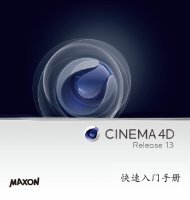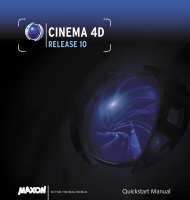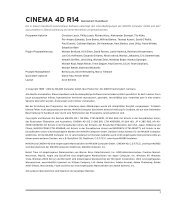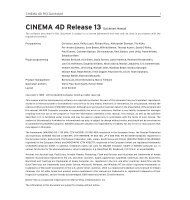Optional module - Maxon Computer
Optional module - Maxon Computer
Optional module - Maxon Computer
You also want an ePaper? Increase the reach of your titles
YUMPU automatically turns print PDFs into web optimized ePapers that Google loves.
234 CINEMA 4D R11 Quickstart – Non-Linear Animation<br />
1. Motion Layer<br />
We will now explore the motion layer method in more detail. Open the file, “QS_ML_Start.c4d” and switch the<br />
CINEMA 4D layout to Animation (top icon in the left Icon Palette, directly below the Undo button). As you can<br />
see, our scene contains a monkey head. We will use this head to create a simple character animation. In the<br />
course of this tutorial we will assign two simple animations to the monkey head: Forward and backward nodding<br />
motion; up-and-down motion. You may wonder why a monkey would ever nod or move its head up and down.<br />
Surely, monkeys that only move their heads back and forth or up and down are extremely rare in the wild (or<br />
even extinct) but we thought a very simple, unrealistic animation would be a better way to demonstrate the<br />
basic principle of non-linear animation (NLA) than having King-Kong push his way through the jungle.<br />
When you play the animation you will see that we have already prepared an animation for you. The monkey<br />
head moves from left to right. Stop the animation and select the “Monkey” Null Object.<br />
Motion layers work together with all recorded keys within a given hierarchy. Simply select the top object in the<br />
hierarchy and all its keys will be included (regardless if it’s a character’s controller or animated geometry).<br />
In the C4D main menu, select the Add Motion Clip… function from the Animation menu. Confirm the window<br />
that opens without making any changes. As you can see, our Timeline now looks different. A motion source<br />
(left) and a motion clip (right) of the Null Object’s (and its Children) animation were created.<br />
The original Keyframes were deleted. If we play the animation again we will see that the left-to-right animation<br />
nevertheless still exists. If we click on the “Monkey” Null Object, though, we will see that no Keyframes exist for<br />
this object. These Keyframes are now located in the motion source that was linked to the Motion Clip. You can<br />
now use the same motion source for more than one Motion Clip. Note that CINEMA 4D automatically switched<br />
to Motion Mode (Timeline menu: View / Motion Mode) when the Motion Clip was added. If you want to modify<br />
the animation contained in this Motion Clip you will have to switch to Key Mode first (Timeline menu: View /<br />
Key Mode). Here you will fine the motion source that can be modified as desired. Since the original Keyframes<br />
for the “Monkey” Null Object no longer exist we can record a new animation and add it as a new source and<br />
clip. The motion system must be deactivated before this is done. With “motion system” we mean deactivating<br />
the complete motion system, not just switching from Motion Mode to Key Mode!<br />
This is done by selecting Edit / Use Motion System in the main CINEMA 4D menu. If the icon has a dark<br />
background it is not active – a light background indicates that it is active. If you cannot see the “Monkey” Null<br />
Object in the left part of the track manager, select Bookmarks / Default Bookmark from the Timeline menu. If<br />
the Null Object is still selected, set a key at frame “0” (click on the “key” icon above the Timeline to set a key).<br />
Go to frame 7 (drag the green grabber below the Viewport to frame 7) and move the monkey head a little to<br />
the front (along the Z-axis) in the Viewport. Set another Keyframe.









